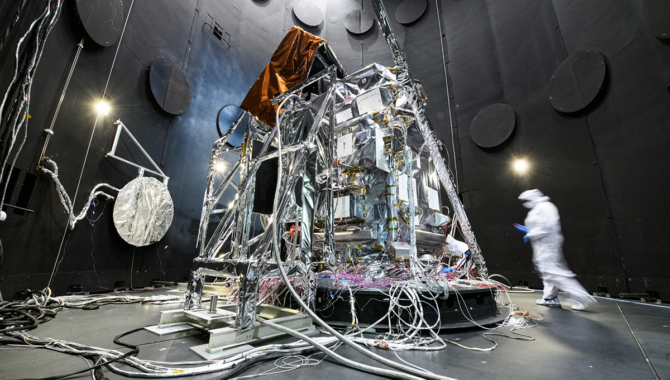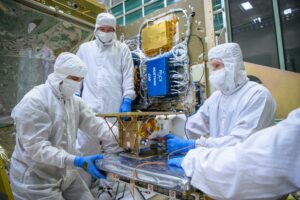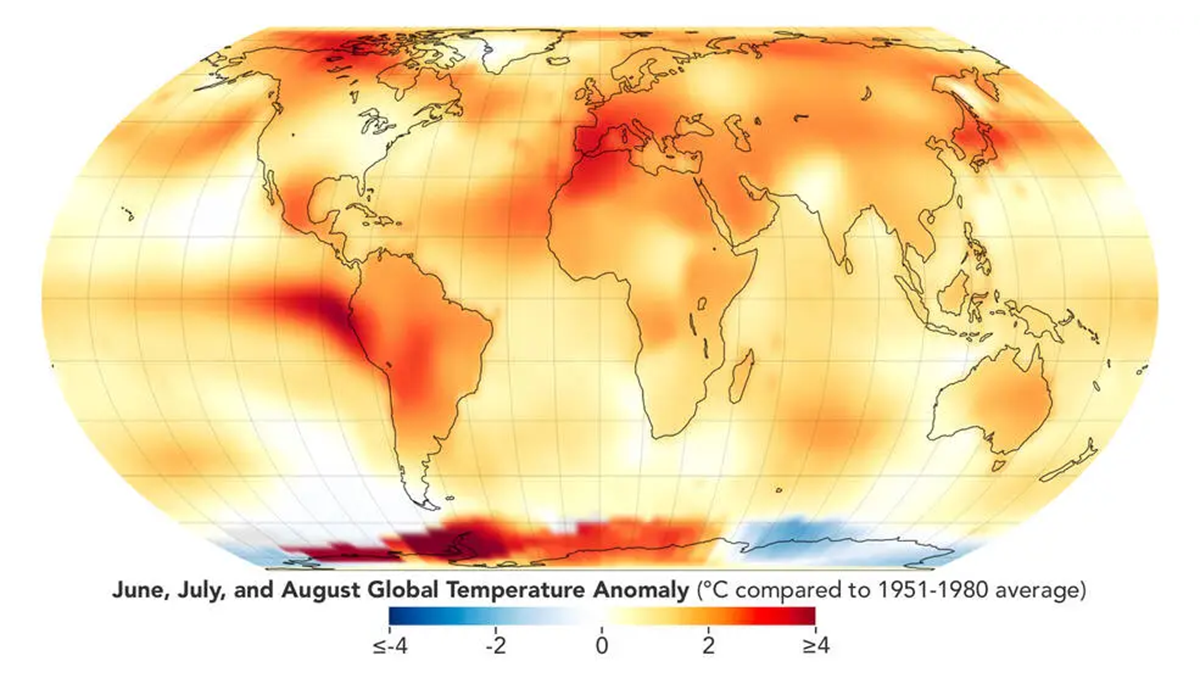
The Plankton, Aerosol, Cloud, ocean Ecosystem (PACE) Observatory inside the Space Environment Simulator (SES) thermal vacuuum chamber before thermal environmental testing at NASA's Goddard Space Flight Center in Greenbelt, Maryland on June 16th, 2023. Photo Credit: NASA/Denny Henry
PACE is a major effort to combine oceanic and atmospheric research to better understand the complex systems.
In early February, NASA is scheduled to launch a mission that, coupled with the latest generation of satellites already in orbit, promises to open a new era of scientific research into the rich, microscopic systems in Earth’s oceans and atmosphere, systems that can have significant impact on Earth’s climate.
The mission is PACE, an acronym for Plankton, Aerosol, Cloud, ocean Ecosystem. The satellite will launch no earlier than February 6, atop a Falcon 9 rocket lifting off from Space Launch Complex 40 at Cape Canaveral Space Force Station in Florida.

An Ocean Color Instrument (OCI) optical lens is installed into the flight housing hardware for alignment measurements.
Photo Credit: NASA/Desiree Stover
“PACE holds the promise of deepening our understanding of how microscopic oceanic and atmospheric particles impact our climate,” said NASA Deputy Administrator Pam Melroy, speaking at a recent NASA media briefing. “It will deliver first-of-a-kind views of the phytoplankton that convert carbon dioxide into cellular material to feed oceanic life. This microscopic aquatic universe provides the backbone of our critical fisheries and plays a major role in drawing carbon dioxide out of our atmosphere.”
“Additionally, PACE aims to unveil the intricate mechanisms by which aerosols and clouds influence the absorption and scattering of the sun’s energy by Earth. Aerosols, as they circulate through the ocean and atmosphere, play a pivotal role in cloud formation, thus influencing the behavior of weather systems. And unraveling this very complex interplay could provide us with invaluable insights into the occurrence of extreme weather events,” Melroy said.
PACE’s primary science instrument is an advanced optical spectrometer known as the Ocean Color Instrument (OCI). OCI is a significant leap forward in technology, with the capacity to measure properties of light in a broad spectrum from ultraviolet to shortwave infrared at much finer wavelength resolutions than previous satellites. The data from OCI will give scientists a more precise picture of global phytoplankton distribution, its abundance, and its diversity.
There are trillions of these tiny, varied, plant-like cells in Earth’s oceans, where they draw vast amounts of carbon dioxide— 100 million tons a day—into the water and convert some of it into organic matter with the help of sunlight and nutrients. Phytoplankton grow quickly in the right conditions, sometimes doubling in mass every day, serving as a ready food source in the marine food chain. They release prodigious amounts of oxygen. Some scientists estimate that about 50 percent of the oxygen in Earth’s atmosphere was produced by phytoplankton.
PACE will also include two polarimeters—the Spectro-polarimeter for Planetary Exploration (SPEXone) and the Hyper Angular Research Polarimeter (HARP2). These polarimeters will gather data on the microphysical properties of aerosols, tiny solid or liquid particles suspended in the air. Aerosols can have a profound impact on climate, either scattering and reflecting sunlight, cooling the atmosphere, or absorbing sunlight and warming it, based primarily on the physical properties of the aerosols.

Technicians prepare to integrate the Hyper-Angular Rainbow Polarimeter #2 (HARP2) instrument to the Plankton, Aerosol, Cloud, ocean Ecosystem (PACE) spacecraft bus at NASA’s Goddard Space Flight Center in Greenbelt, Maryland on October 25th, 2022.
Photo Credit: NASA/Denny Henry
“These aerosols are air pollutants, but they also have an important effect on climate, because they cool the Earth and mask the warming by greenhouse gases, but we really don’t know by how much,” said Otto Hasekamp, an Atmospheric Scientist with the Netherlands Institute for Space Research. Hasekamp is the principal investigator for the SPEXone polarimeter.
PACE will gather crucial data about the size distribution, abundance, refractive qualities, and shapes of these aerosols, which play a pivotal role in cloud formation, the behavior of weather systems, and the radiative forcing of climate change. This data has the potential to reduce uncertainty in climate models.
“PACE represents a major effort to truly combine ocean research with atmospheric research. We are going to go beyond just seeing that Earth’s climate is changing to better understanding why the change is occurring,” said PACE Project Scientist Jeremy Werdell.
“PACE is a great example of NASA’s ability to develop innovative technology, put it in orbit, develop advanced scientific research, build models from that understanding, and then deliver applications that are useful to society,” said Karen St. Germain, Director of NASA’s Earth Science Division, speaking at the NASA media briefing.
The information PACE collects on orbit “is going to greatly advance and add to our understanding of ocean biology and the relationship between ocean life and our atmosphere. Integrating PACE science and data with research and information on the ocean’s physical science that we’re getting from SWOT (the Surface Water and Ocean Topography satellite), which we launched a little more than a year ago, we’re going to enter into an entirely new era of ocean science,” St. Germain said.
PACE is managed by NASA’s Goddard Space Flight Center. To learn more about the mission, click here.










